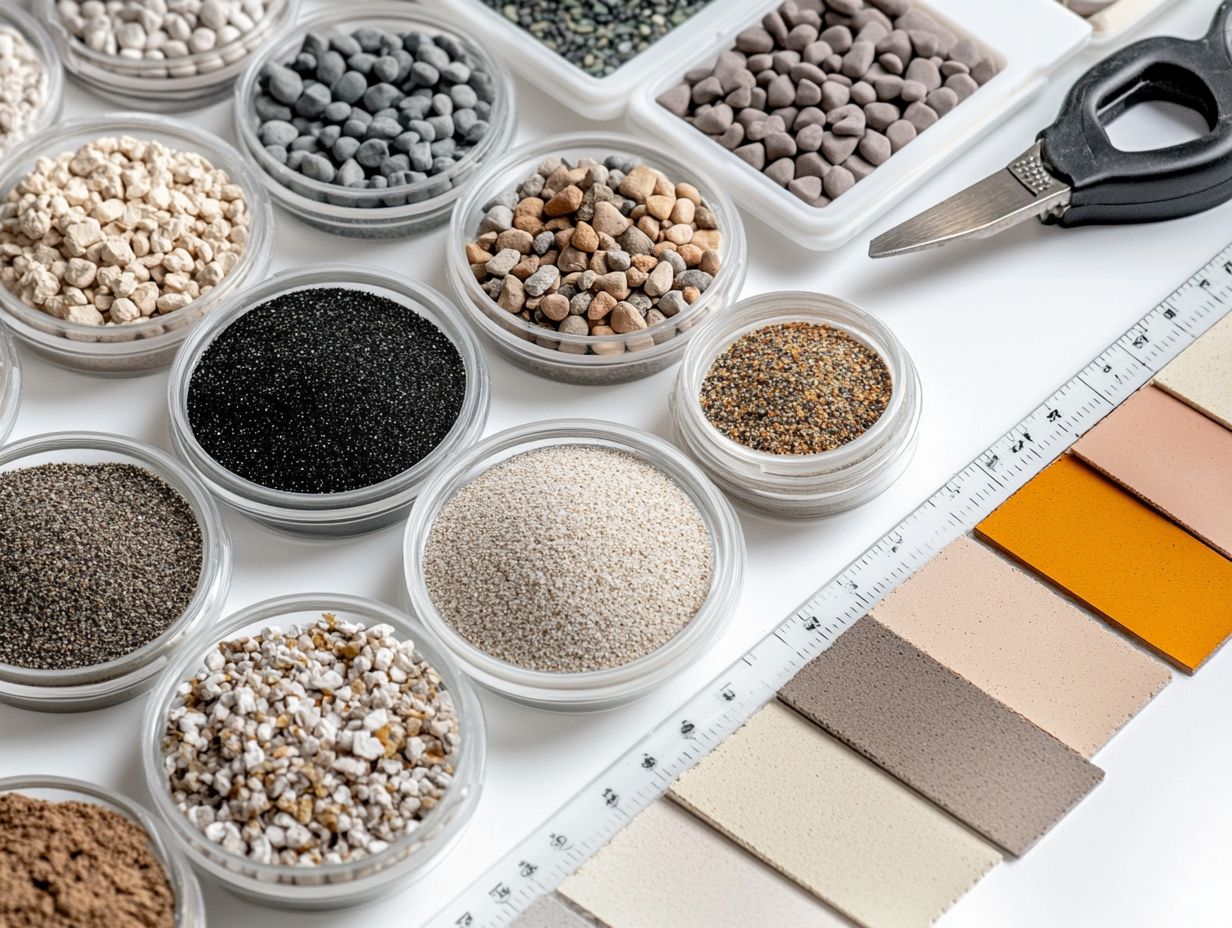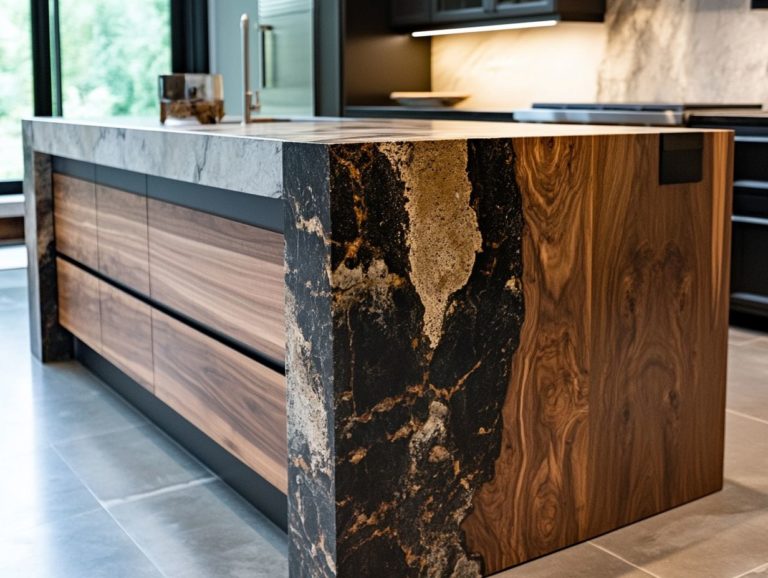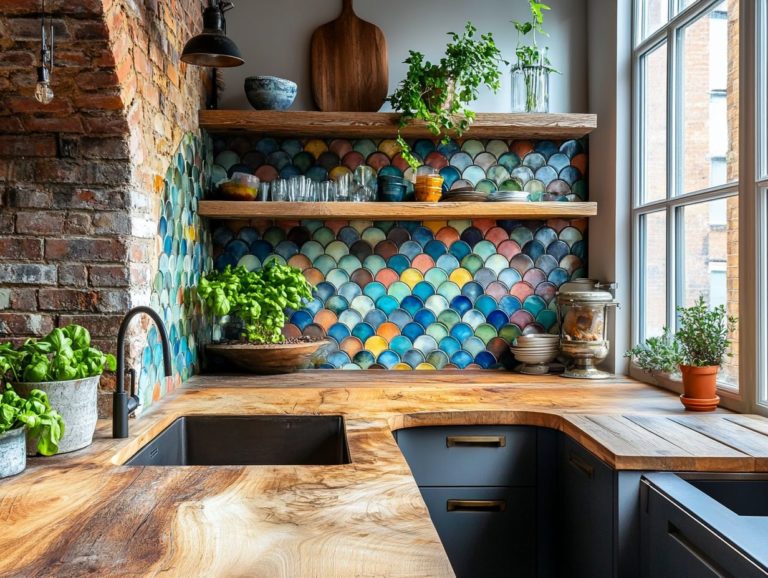How to Choose the Right Grout for Your Kitchen
Pick the right grout, and watch your kitchen transform in both function and style!
This article delves into why grout is important in your home. You’ll discover the different types of grout—cement, epoxy, and urethane—and explore key factors to consider, such as color and durability.
A step-by-step guide will help you assess your kitchen’s unique needs and keep your grout in pristine condition.
Whether you’re renovating or simply refreshing your space, this guide will empower you with the knowledge you need to make an informed grout choice.
Contents
- Key Takeaways:
- Types of Grout for Kitchen Use
- Factors to Consider When Choosing Grout
- Step-by-Step Guide to Choosing the Right Grout
- Maintaining and Repairing Kitchen Grout
- Frequently Asked Questions
- What is grout and why is it important to choose the right one for my kitchen?
- What are the different types of grout that I can choose from for my kitchen?
- How do I choose the right color for my grout?
- What factors should I consider when choosing a grout for my kitchen?
- Is there a difference between grout for walls and grout for floors?
- Can I change the color of my grout after it has been installed?
Key Takeaways:

- Choose the right grout to prevent damage and maintain the appearance of your kitchen.
- Consider color, durability, and maintenance needs when selecting grout for your kitchen.
- Consult with professionals and assess your kitchen’s needs before making a decision.
What is Grout and Why is it Important?
Grout is essential in tile installation. It serves not just as a filler for joints but also influences the design aesthetics of your space. With various colors available, each choice impacts the room’s perception and ambiance.
When deciding between matching and contrasting grout, you’re choosing between a harmonious look and enhanced visual complexity. This is crucial for any tile project.
Grout also preserves the functionality of tiled surfaces, acting as a barrier against dirt and water. This protective layer helps prevent damage, extending the life of your tiles.
Proper grout maintenance is essential. Regular sealing can thwart staining and reduce mildew growth, keeping your space fresh and inviting. The right grout color doesn’t just complement the tiles; it can also affect the room’s lighting and spaciousness.
These important design choices deserve your careful consideration. Grout is far more than an afterthought; it is a foundational element that beautifully marries aesthetics with practicality in tiling.
Types of Grout for Kitchen Use
Understanding the nuances of different grout types is crucial for a successful kitchen renovation. The main varieties at your disposal—cement grout, epoxy grout, and urethane grout—each have unique advantages tailored to meet specific requirements like durability and stain resistance.
Selecting the appropriate grout can significantly influence both the integrity of your tile patterns and the overall aesthetic appeal of your kitchen.
Comparing Cement, Epoxy, and Urethane Grout
Cement grout is popular due to its cost-effectiveness and ease of application. However, it can crack and stain over time, especially in areas that get wet often, like bathrooms.
On the other hand, epoxy grout resists moisture and stains, making it ideal for high-traffic areas. However, expect a more intricate and time-consuming installation process.
Urethane grout provides exceptional flexibility and requires less maintenance, making it an excellent choice for kitchens and outdoor spaces.
When selecting grout, evaluate your specific environment and usage requirements to ensure optimal performance and durability.
Don’t wait! Choosing the perfect grout now can save you headaches down the road.
Factors to Consider When Choosing Grout

When selecting grout for your tile project, consider factors like color, durability, and maintenance.
Your grout choice affects both the look and function of your space. By understanding tile undertones and color pairings, you can enhance your area’s design.
Weigh practical factors, like how long your grout lasts and how easy it is to clean. This will help you achieve lasting beauty that withstands the test of time.
Color, Durability, and Maintenance Needs
The grout color significantly impacts your tiled surfaces, affecting visual focus and space perception. Opt for durable grout that resists moisture and stains for long-term satisfaction.
Choosing a grout color that complements your tile’s hue enhances the room’s overall appeal.
Lighter shades can make small areas feel bigger, while darker hues add depth. Consider your tile’s colors to make an informed choice—complementary shades highlight designs, and contrasting colors create interest.
Stain-resistant grout simplifies cleaning, keeping your tiles beautiful over time. The right choice not only enhances visual impact but also contributes to a cohesive design.
Step-by-Step Guide to Choosing the Right Grout
Selecting the right grout requires a systematic approach. Focus on grout selection, tile installation techniques, and renovation insights.
A well-planned process helps ensure that the grout aligns with your design goals and practical needs.
Assessing Your Kitchen’s Needs
Start by assessing your kitchen’s specific needs. Understand both practical and aesthetic factors that matter for your renovation.
Consider moisture levels, foot traffic, and design choices. These will guide your grout selection for both function and style.
If your kitchen has high humidity, choose grout that resists mildew. Think about traffic patterns too, to ensure your grout can handle heavy use without quickly showing wear.
Design matters too. The right grout color and texture can enhance your countertops and cabinetry, elevating your kitchen’s look.
This assessment creates a blend of beauty and durability, tailored to your kitchen’s needs.
Consulting with Professionals

Consulting professionals offers valuable insights into grout selection and tile installation. They ensure your project meets both your style and practical needs.
Experts can recommend materials that align with your design preferences and provide tailored maintenance tips.
They understand different grout types, like epoxy, which is a strong adhesive, and can evaluate your space’s conditions. This helps you choose a durable grout that’s easy to maintain.
When hiring a specialist, check their credentials, experience, and past projects. Their guidance can streamline your decision-making and help you invest confidently in materials.
Maintaining and Repairing Kitchen Grout
Proper maintenance and repair of your kitchen grout are crucial for preserving its appearance and functionality over time. Regular cleaning and addressing repairs promptly can help prevent issues like discoloration and cracking, significantly enhancing the longevity of your tile investment.
Understanding how to keep grout clean, along with the best practices for fixing cracks or discoloration, will ultimately save you time and effort in the long run. Start your cleaning routine this weekend to see immediate results!
Tips for Keeping Grout Clean and in Good Condition
To keep your grout looking pristine and functioning optimally, it’s vital to implement effective cleaning tips. Regular maintenance is key to preventing dirt and stains from building up, ensuring that your tiled surfaces remain fresh and welcoming.
By understanding the specific maintenance needs of the grout type you’ve chosen, you can enhance its longevity even further. For instance, epoxy grout, a strong type of grout that resists stains and moisture, requires less frequent deep cleaning than traditional cement-based grout, which may need dedicated scrubbing and sealing.
Establishing a regular cleaning routine tailored to the unique properties of each grout type simplifies your upkeep process. Additionally, it helps you avoid more significant repair costs in the future.
By prioritizing proper cleaning techniques, such as using pH-balanced cleaners and soft-bristle brushes, you’ll elevate the visual appeal of your tiled spaces, ensuring they remain a beautiful focal point in your home.
How to Fix Cracked or Discolored Grout
Fixing cracked or discolored grout is essential for maintaining the elegance of your tile installation and can dramatically enhance its overall appearance. You have various repair techniques at your disposal, such as grout reapplication and color matching, but careful grout testing is crucial for compatibility.
To begin, use a grout saw or similar tool to remove any damaged sections before applying a fresh mix. If the discoloration is minor, a simple cleaning solution might be sufficient to restore its original hue.
Testing different products on a small, inconspicuous area is vital. This ensures that the new grout adheres well and blends seamlessly with the existing material.
After your repair, don’t overlook the importance of selecting sealing options to enhance durability, prevent moisture infiltration, and extend the life of your grout.
Frequently Asked Questions

What is grout and why is it important to choose the right one for my kitchen?
Grout is a filling material used to seal gaps between tiles. Choosing the right grout for your kitchen is important because it affects the appearance of your tiles and plays a crucial role in preventing water damage and maintaining their longevity.
What are the different types of grout that I can choose from for my kitchen?
You can choose from three main types of grout: sanded, unsanded, and epoxy. Sanded grout is best for wider grout lines and is more durable. Unsanded grout is ideal for narrower grout lines and is easier to work with. Epoxy grout is the most durable and stain-resistant but requires special mixing and application techniques.
How do I choose the right color for my grout?
The color of your grout can greatly impact the overall appearance of your kitchen. For a classic look, choose a color that closely matches your tile. For a more dramatic effect, select a contrasting color. Also, consider the amount of natural light in your kitchen, as this can affect how the grout color appears.
What factors should I consider when choosing a grout for my kitchen?
When choosing grout for your kitchen, consider the type of tile you have, the location of your kitchen (e.g., backsplash vs. floor), and the level of foot traffic. You should also factor in the maintenance and upkeep required for each type of grout.
Is there a difference between grout for walls and grout for floors?
Yes, there is a difference! Floor grout is designed to be more durable and can handle heavy foot traffic. In contrast, wall grout might crack or stain more easily.
It’s best to consult a professional to find the right grout for your kitchen.
Can I change the color of my grout after it has been installed?
Yes, you can change your grout color! However, it can be tricky and might take some time.
It’s smart to pick the right color from the start to avoid mismatched patches later.





